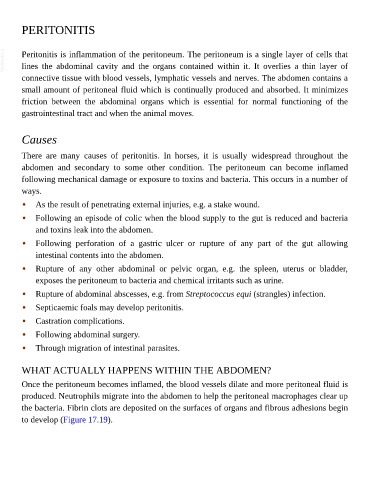Page 797 - The Veterinary Care of the Horse
P. 797
PERITONITIS
VetBooks.ir Peritonitis is inflammation of the peritoneum. The peritoneum is a single layer of cells that
lines the abdominal cavity and the organs contained within it. It overlies a thin layer of
connective tissue with blood vessels, lymphatic vessels and nerves. The abdomen contains a
small amount of peritoneal fluid which is continually produced and absorbed. It minimizes
friction between the abdominal organs which is essential for normal functioning of the
gastrointestinal tract and when the animal moves.
Causes
There are many causes of peritonitis. In horses, it is usually widespread throughout the
abdomen and secondary to some other condition. The peritoneum can become inflamed
following mechanical damage or exposure to toxins and bacteria. This occurs in a number of
ways.
• As the result of penetrating external injuries, e.g. a stake wound.
• Following an episode of colic when the blood supply to the gut is reduced and bacteria
and toxins leak into the abdomen.
• Following perforation of a gastric ulcer or rupture of any part of the gut allowing
intestinal contents into the abdomen.
• Rupture of any other abdominal or pelvic organ, e.g. the spleen, uterus or bladder,
exposes the peritoneum to bacteria and chemical irritants such as urine.
• Rupture of abdominal abscesses, e.g. from Streptococcus equi (strangles) infection.
• Septicaemic foals may develop peritonitis.
• Castration complications.
• Following abdominal surgery.
• Through migration of intestinal parasites.
WHAT ACTUALLY HAPPENS WITHIN THE ABDOMEN?
Once the peritoneum becomes inflamed, the blood vessels dilate and more peritoneal fluid is
produced. Neutrophils migrate into the abdomen to help the peritoneal macrophages clear up
the bacteria. Fibrin clots are deposited on the surfaces of organs and fibrous adhesions begin
to develop (Figure 17.19).

